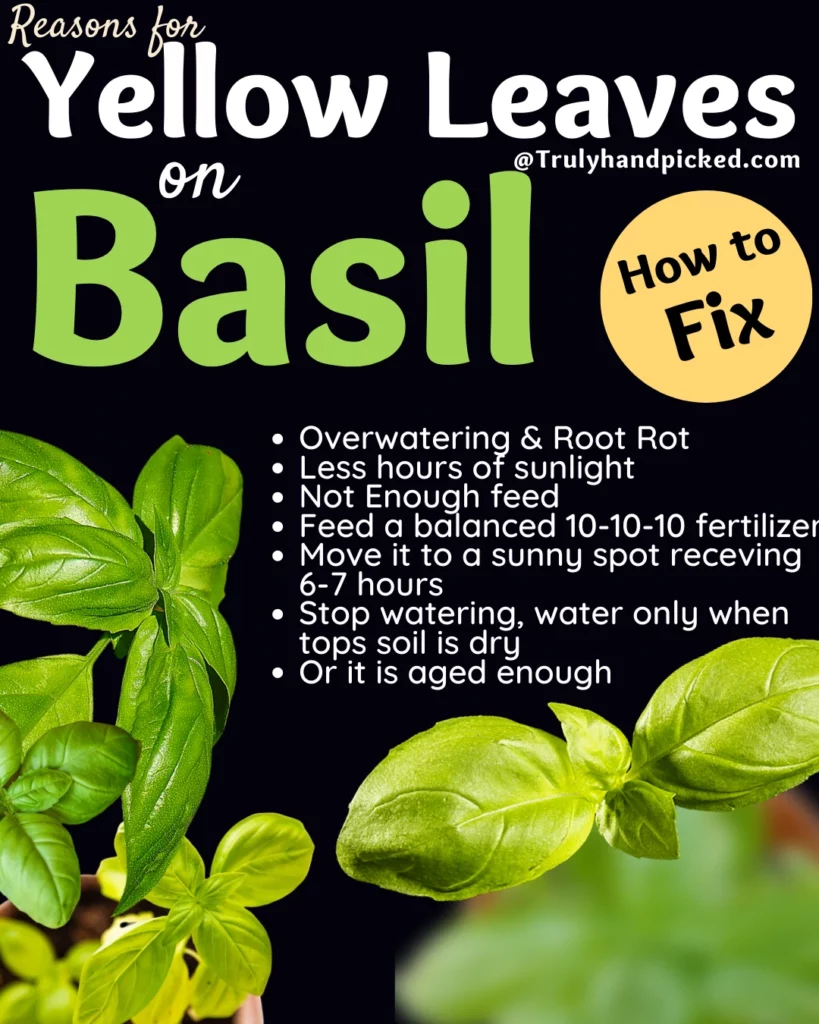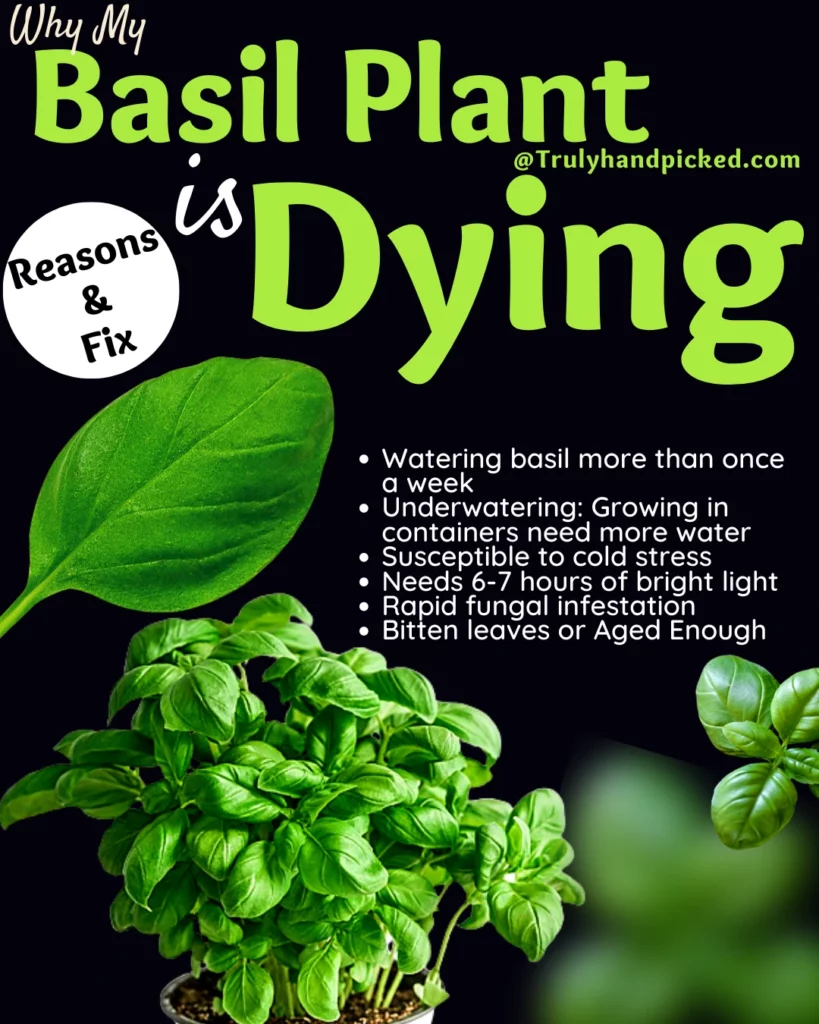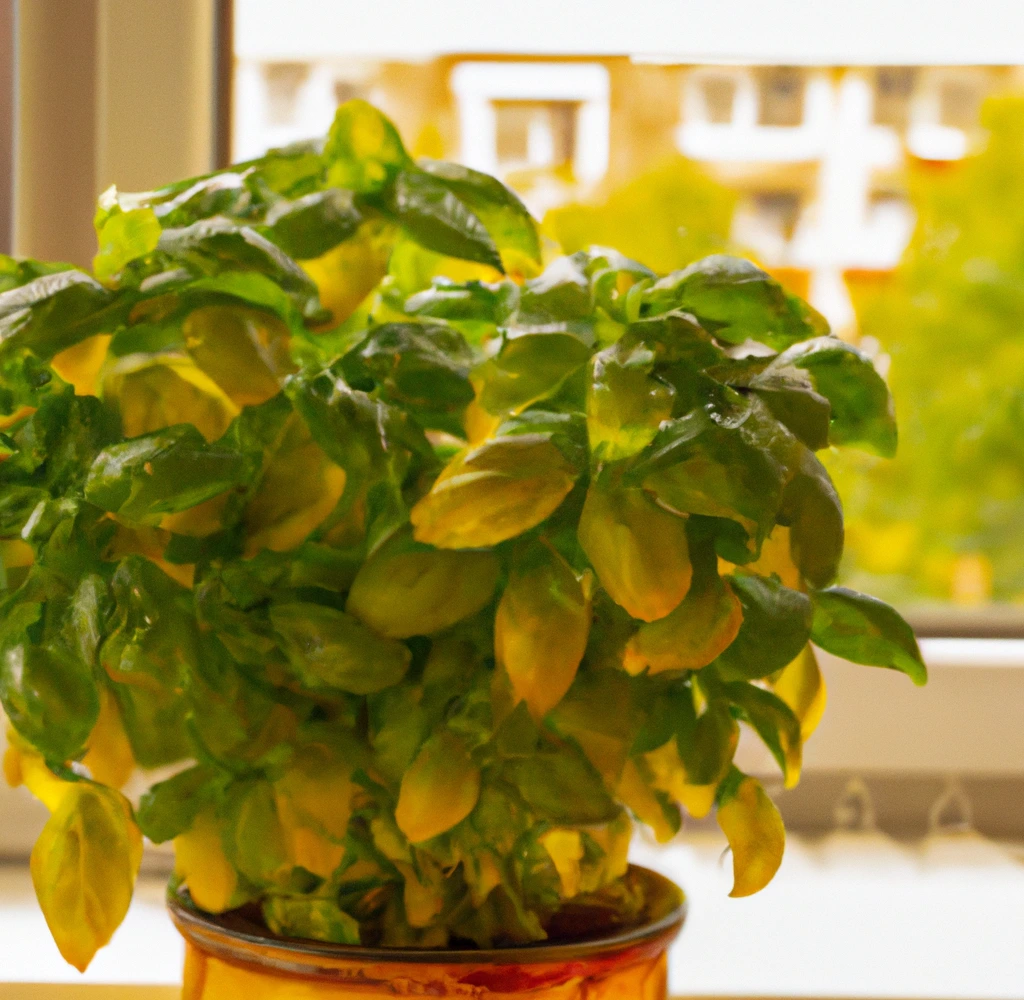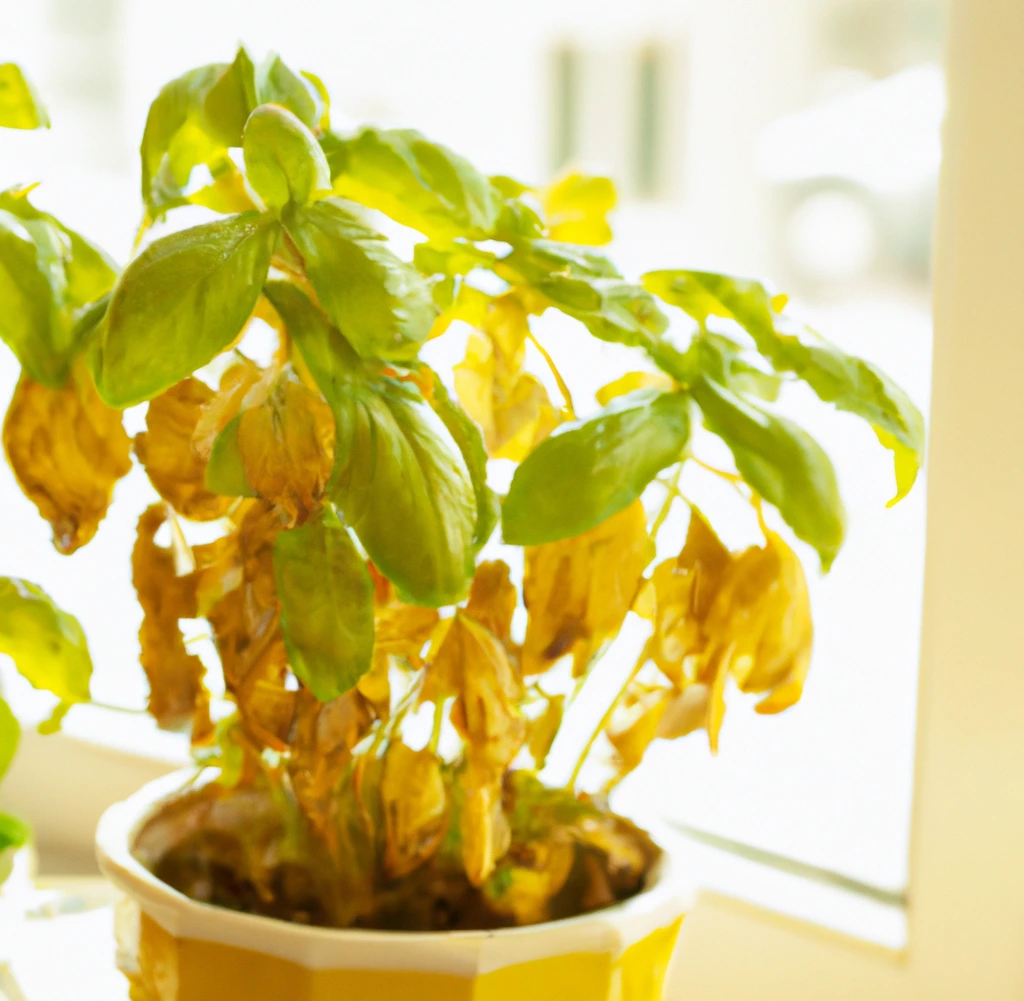Contents: Reasons why basil leaves are turning yellow, how to fix dying basil plants, harvest basil without hurting the plant, and FAQ on basil plant care.
Reasons in Short: Why Basil Leaves Turn Yellow
- Overwatering: Excessive moisture can lead to yellowing basil leaves.
- Underwatering: Insufficient watering can cause stress and turn basil leaves pale.
- Nutrient deficiencies: Lack of essential nutrients, particularly nitrogen, can result in yellow leaves.
- Poor drainage: Improper drainage can cause root rot and yellowing leaves.
- Pests and diseases: Infestations or diseases like downy mildew can cause the yellowing of basil leaves.
- Environmental stress: Extreme temperatures, high humidity, or exposure to direct sunlight can lead to yellowing leaves.
- Aging leaves: Older basil leaves naturally turn yellow as they age and should be pruned.
Overview: Basil is a culinary herb that thrives easily in a home climate without any extra caring initiatives. This perennial herb has great value in the culinary field. Basil leaves are used in various types of cuisines around the world.
Its aromatic sweet smell adds an extra flavor to any recipe in an exclusive way. This one from the Lamiaceae family is a perfect plant for any indoor herb garden.
Why Basil Leaves Are Turning Yellow? How to Save?
Basil plant grows gorgeous green foliage in small leaf-shape. Sometimes, a few undetected causes can let your plant leaves turn yellow.

This is a clear sign of an unhealthy basil plant. If your basil leaves turn yellow before their proper older stage, there must be some unsorted issues that bother your plant constantly. Yellow leaves often lose their flavor and fragrance eventually.
Thus, today, here we come up with the possible causes of why basil leaves turn yellow and what you can do about solving this problem perfectly-
Reasons Why Basil Has Yellow Leaves
- Over sun-exposed
- Interrupted photosynthesis process due to lack of light
- Overwatering
- Frequent cold stress
- Contact with open drafts
- Overcrowded plants due to unpruned seasons
- Nutrient deficiency due to poor fertilization
- Untreated diseases
- And uncured pests and bugs attack
Related: How to fix hibiscus leaves turning yellow – quick tips
How to Fix Yellowing Leaves
- Let your plant soak under bright and direct sunlight for 6-7 hours per day
- Keep your plant away from the dapple sun and direct sunlight
- Water your basil plant mindfully with 1-inch water per week
- Never place your plant in a full shady spot or near any open windows
- Install grow lights for your plant if you can’t provide your growing basil with enough natural light
- Set a weekly or monthly pruning session for your plant to keep it safe from being overcrowded
- Feed your plant every two weeks with a slow-release organic vegetable fertilizer in liquid form
- Treat and control any fungal and bacterial infestation in every possible way, once you ever detect one on your plant before it affects the roots
- Keep your plant safe from common basil insects attentively. Some typical basil pests are-Japanese beetles, aphids, mealybugs, slugs, etc.
- Give your plant a good rinse of homemade pesticide sprays to keep their attack at bay.
Read more: Can my basil plant survive winter
Why Is My Basil Plant Dying?

Basil or great basil is a simple tropical plant and thus, quite hardy when it comes to the matter of tolerating surrounding circumstances.
Despite being hardy, basil plants sometimes go towards their fatal outcome of constant negligence. Here are some possible ideas of why and how a growing basil plant suddenly starts dying along with some of their fixing tips-
Excessive Watering:
Watering more than the requirements of a plant is overwatering. A basil plant can’t stand this issue ever in its entire growing period.
Watering basil more than once a week or before drying the soil drags it to the overwatering signs. Overwatering often does instigate these problems in your plant-
- Soggy growing medium
- Suffocated roots
- Wilted leaves
Solutions:
- Water with a proper schedule like every 7 to 10 days
- Always use potting mix and pot with a good drainage system
- Never water your basil plant until the topsoil turn dry completely
Related: Why my rosemary plant is dying – how to fix
Drought Stress:
Underwatering or drought stress may not be a bigger problem for a growing basil plant but it often turns deadly after remaining untreated for a long.
To keep your plant away from drought stress, you need to keep it well-hydrated with a proper watering schedule. Keeping your plant underwatering may initiate these issues in your plant-
- Wilted leaves
- Crispy foliage and stems
- And eventually dead plant
Solutions:
- Set a suitable watering schedule depending on the sun-exposure timing of your plant
- Don’t keep your plant dehydrated with dry soil for long
- Install a self-watering pot for your growing basil plant, if you are not around your plant for a while
Related: Best aromatic herbs for your kitchen garden
Cold Stress:
Due to being of tropical origin, the basil plant turns susceptible to cold stress. It can stand frost but only with proper protection methods.
Otherwise, you must keep your plant away from open cold drafts attentively. Cold stress can cause some serious damage to your basil plant such as-
- Wilted plant
- Unwanted hydration
- Poor evaporation
Solutions:
- Don’t let your plant stay unprotected from open window drafts
- Keep your plant away from open windows or doors during winters
- And keep the outside basil planter inside your house until the frost gone
Related: Why my geraniums are dying Reasons and fix
Improper Light:
This aromatic herb has a basic requirement of light in its regular growing period. You must cater your basil plant to an optimal amount of sunlight daily.
The light should be bright but indirect. You should be attentive to providing the right percentage of sunlight to your plant in this regard. Otherwise-
- Your plant will turn leggy in search of adequate sunlight
- Basil plants may get sunburned through scorching direct sunlight
- Crispy leaves with less than 4 hours of bright light a day
Sunlight is the lifeblood of basil plants! But sometimes, our green friends don’t get the sun-soaked days they deserve, and that can lead to some basil blues.
When basil doesn’t get enough sunlight, it starts to feel a bit down in the dumps. Its leaves may lose their vibrant green and take on a faded, lackluster appearance. Think of it like basil on a cloudy day – not quite as happy and perky as when it’s basking in the sun’s warm embrace.
But wait, there’s more! Insufficient sunlight can also cause the basil to stretch and grow leggy, like a plant reaching out for a friendly hug from the sun. Those stems start to elongate, and your once bushy basil starts to look more like a lanky teenager going through a growth spurt.
Solution
“Find the Sunny Spot.” Look around your home or garden for the sunniest spot available. Basil craves at least 6 to 8 hours of sunlight each day, so aim to place it in this bright and cheerful location.
If Mother Nature isn’t providing enough natural light, don’t fret! It’s time to introduce our basil buddy to the world of grow lights. These fancy gadgets mimic the sun’s rays, giving your basil the light it craves, even on cloudy days. It’s like having a personal sun for your basil to party under!
Related: How to save a dying watermelon peperomia
Untreated Pests and Diseases:
Disease and bugs attack both are dangerous for any growing herb including this great basil. Basil plants can have two deadly diseases which often turn fatal for your plant.
They are root rot and fusarium wilt. Root rot often occurs due to waterlogged conditions, while fusarium wilt appears due to fungal infections.
On the other hand, insect attacks are quite normal for such scrumptious herbal plants. Some basic issues the basil plant may have with these problems are-
- Rapid fungal infestation
- Wilted plant
- Soggy soil
- Nutrient deficiency
- And bitten leaves as well as stems
Related: Are basil flowers edible
Solutions:
- Keep your plant in good dry condition with a proper light supply
- Never keep your plant in anaerobic condition as it weakens the roots badly
- Provide protection and apply remedies to keep the pests’ attacks at bay with organic methods
Unsolved Issues:
Keeping your plant inattentive and letting it suffer with untreated issues for a long often lead your basil plant toward a lethal outcome.
So, you must not keep your plants neglected for long or they will die with their unsolved issues shortly. Unsolved troubleshoots issues may occur in your basil plant as-
- Stunt growth
- Unhealthy foliage
- Dry stems
- And a plant that is losing its true form gradually
Solutions:
- Provide your plant with its basic needs accurately
- Give your plant a good check every two-three day
- Never let your plant suffer from untreated troubleshooting issues ever for long
Don’t skip any step unchecked once you find that your growing basil plant is dying without any logical reason. Try to recognize the signs at their primary stage and apply their suitable solutions accordingly.
This way you will get a chance to revive that dying plant inevitably.
Soil Care for Basil to Prevent Yellow Leaves
Basil likes its soil to be like a cozy blanket – well-draining and comfy! It doesn’t want its roots to feel like they’re stuck in a soggy swamp. So, choose a light and loamy soil mix that allows excess water to sneak away like a ninja.
Now, the key to keeping our basil buddy thriving is making sure it’s not drowning in water! When you water, give it a good soak, but then let the top inch of soil dry out before the next watering session. It’s like a perfect hydration routine, not too much and not too little.
Our basil craves some good nutrients too, just like we crave a tasty meal. So, feed it with a balanced liquid fertilizer every couple of weeks during its growing season. It’s like serving up a yummy dish just for your basil!
Now, here’s the deal – basil is a hungry herb, so don’t be shy with the fertilizer love, but don’t overdo it either. Too much food can lead to burnt leaves and not-so-happy basil. Moderation is the key.
Recap: Choose well-draining, loamy soil, water wisely, fertilize with love and moderation, and let your basil bask in the sun’s warm embrace. With this simple soil care routine, your basil will be flourishing like a superstar.
Wrinkled Basil Plant Leaves (Reasons)
- Underwatering: Insufficient watering can cause basil leaves to wrinkle and wilt.
- Overwatering: Excessive watering leads to root rot, inhibiting water absorption and resulting in wrinkled leaves.
- Inadequate humidity: Dry air and low humidity levels can cause basil leaves to lose moisture and become wrinkled.
- Insufficient sunlight: Lack of proper sunlight exposure can affect basil’s growth, causing leaves to shrivel and wrinkle.
- Nutrient deficiencies: Inadequate levels of essential nutrients, especially nitrogen, can lead to leaf wrinkling.
How To Harvest Basil Without Hurting The Plant?
Basil plants are sensitive due to their fragile stems and super-soft leaves. Thus, they often get hurt during the process of pruning and harvesting.
However, you can avoid this unfortunate outcome by following a few simple cautioning tips in this regard. They are as follows-
- Find a node where two leaves attached to a stem
- Cut exactly above the node and pinch the tip-off
- Try to harvest the stems from the top down by leaving one leaf pair at the bottom
- Make sure you hold the place where leaves are approaching the main stem
- Hold the place gently and cut with a sharp object quickly
- Try to set the measurement up to 1/3 of the topmost basil leaves in a single harvesting session to let it live without killing or hurting from any aspect.
FAQ: Does Basil Plant Bloom Ever?
Basil blooms from June to Frost every year in nice purple to elegant white tint with a mild fragrance. Blossoms taste similar to the leaves with a mild flavor comparing the great basil leaves.
Why do Basil Leaves Grow Small?
A growing basil plant suddenly grows smaller leaves than its usual size due to some improper caring regimen; such as lack of nutrients; insufficient sunlight, small or improper containers; and poor soil.





